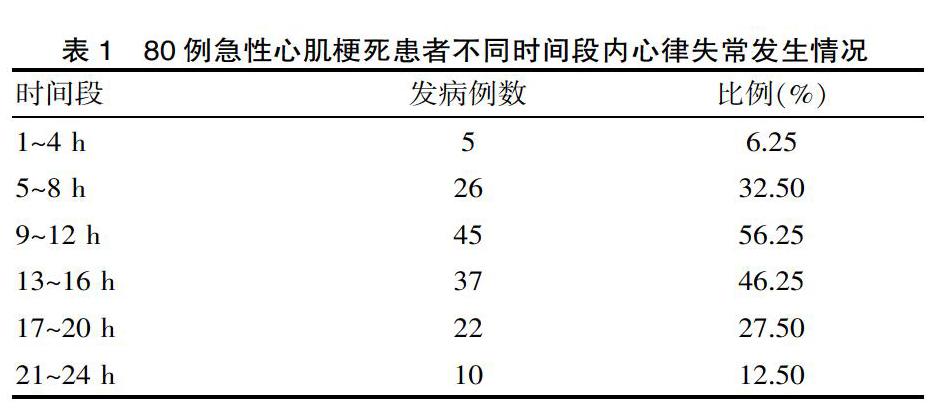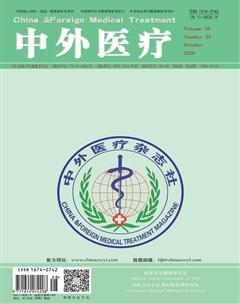急性心肌梗死后心律失常的发生时间及护理
徐娟



[摘要] 目的 探究急性心肌梗死后心律失常的發生时间以及护理方法。 方法 方便选择该院2018年12月—2019年12月收治的80例急性心肌梗死后心律失常患者。按照护理方式不同进行分组,分成对照组(常规护理)、观察组(在对照组基础上采用针对性护理)。了解不同时间段患者发生心律失常的情况,对比两组急性心肌梗死患者护理前后心功能指标、并发症发生率以及护理满意度。结果 急性心肌梗死患者发生心律失常最集中的时间段为凌晨5点到下午4点,发生时间段比较少的时间为下午5点到次日凌晨4点。护理前的心功能指标对比差异无统计学意义(P>0.05);实施护理后,急性心肌梗死患者的LVEF分别为对照组(44.65±3.54)%、观察组(52.81±3.51)%(t=10.352 P<0.001)。LVEDD分别为对照组(61.40±2.31)mm、观察组(52.64±2.50)mm(t=16.277,P<0.001);对照组患者的LVESD为(55.35±2.35)mm,观察组患者的LVESD为(50.23±2.64)mm(t=9.162,P<0.001)。观察组患者护理后并发症发生率为5.00%低于对照组20.00%(χ2=4.114,P=0.042),护理满意度高于对照组,组间数据比较,差异有统计学意义(P<0.05)。观察组患者的护理满意度评分为(92.91±3.62)分,高于对照组患者的(82.40±3.12)分,差异有统计学意义(t=13.909,P<0.001)。 结论 急性心肌梗死患者实施针对性护理措施后,能够改善患者心功能,减少并发症发生,值得推荐。
[关键词] 急性心肌梗死;心律失常;发生时间;心功能
[中图分类号] R473.74 [文献标识码] A [文章编号] 1674-0742(2020)11(a)-0135-03
The Occurrence Time and Nursing of Arrhythmia after Acute Myocardial Infarction
XU Juan
First Ward of Cardiology Department, Central Hospital of Zibo Mining Group Co., Ltd. Zibo, Shandong Province, 255120 China
[Abstract] Objective To explore the occurrence time of arrhythmia after acute myocardial infarction and the nursing methods. Methods convenient select 80 patients with arrhythmia after acute myocardial infarction in the hospital from December 2018 to December 2019. According to different nursing methods, they were divided into control group (routine nursing) and observation group (use targeted care based on the control group). To understand the occurrence of arrhythmia in patients at different time periods, to compare the cardiac function indexes, complication rate and nursing satisfaction of the two groups of acute myocardial infarction patients before and after nursing. Results The most concentrated period of arrhythmia in patients with acute myocardial infarction is from 5 am to 4 pm, and the time when the time period is relatively small is from 5 pm to 4 am the next day. There was no statistically significant difference in cardiac function indicators before nursing (P>0.05); after nursing, the LVEF of patients with acute myocardial infarction were (44.65±3.54)% in the control group and (52.81±3.51)% in the observation group (t=10.352, P<0.001). LVEDD was (61.40±2.31) mm in the control group and (52.64±2.50) mm in the observation group (t=16.277, P<0.001); the LVESD of the control group was (55.35±2.35) mm, and the LVESD of the observation group was (50.23±2.64) mm (t=9.162, P<0.001). The incidence of complications after nursing in the observation group was 5.00% lower than 20.00% in the control group (χ2=4.114, P=0.042), and the nursing satisfaction rate was higher than that in the control group. There was statistically significant difference in the data comparison between the groups (P<0.05). The nursing satisfaction score of the observation group was (92.91±3.62) points, which was higher than the (82.40±3.12) points of the control group, and the difference was statistically significant (t=13.909, P<0.001). Conclusion The targeted nursing measures for patients with acute myocardial infarction can improve the patient's heart function and reduce the occurrence of complications. It is worth recommending.
3 讨论
如今,随着高血压、糖尿病等内科疾病发病率不断提高,心血管疾病发病率呈现上升趋势。其中,急性心肌梗死作为常见的心血管疾病之一,具有较高的致死率,严重威胁到患者的生命安全。心律失常属于急性心肌梗死患者常见的并发症之一,是导致患者死亡的主要因素。
在文中可以看出在5~8、9~12、13~16 h这3个时间段内,急性心肌梗死患者发生心律失常的次数最多,导致这种情况出现的主要原因可能是昼夜节律性变化可能会导致体内神经内分泌发生变化。部分研究表明,急性心血管事件如心肌缺血、心肌梗死、猝死、室性心律失常等并发症的发生均主要集中于上午,是由于儿茶酚在凌晨5点到上午12点间分泌量不断增加,儿茶酚的不断增加会导致患者血压显著升高,心率上升,心脏收缩力增强,血小板聚集率增强,纤溶系统功能降低,从而导致急性心肌梗死患者发生心律失常[8-9]。
因此在急性心肌梗死患者容易发生心律失常的时间段内,护理人员需要展开针对性护理服务,密切监测患者的生命体征,加强心电监护,及时发现患者病情变化,争取抢救时机。提前准备好相关抢救器材、药品,并保证完整性,从而提高抢救成功率。同时护理人员还需要做好急性心肌梗死患者的健康教育与心理护理,保证患者身心健康,减少其他因素加重患者的病情,阻碍患者治疗。
在该次研究中,可以看出从凌晨5点到下午4点是急性心肌梗死患者发生心律失常的主要时间段,在该阶段内对患者采取针对性护理干预,有助于改善患者病情,改善患者心功能,提升患者护理满意度,观察组患者的各项指标与对照组比较,差异有统计学意义(P<0.05)。在陈淑云[10]的研究中,观察组患者给予循证护理后,患者心动过速等并发症发生率为8.50%,低于对照组的35.9%,组间差异有统计学意义(P<0.05)。这与该次研究结果相符合。该次研究中,观察组患者的并发症发生率为5.00%,小于对照组的20.00%,组间差异有统计学意义(P<0.05)。
综上所述,急性心肌梗死患者入院接受治疗后,在凌晨5点到下午4点需要提高重视程度,对患者采取积极有效的护理服务,从而降低心律失常发生,从而降低病死率,提高临床疗效。
[参考文献]
[1] 关杰.老年急性心肌梗死合并心律失常的护理研究[J].中国医药指南,2019,17(4):290-291.
[2] 马丹丹.循证护理在急性心肌梗死后心律失常护理中的应用[J].中国医药指南,2019,17(7):168-169.
[3] 赵宁宁,刘云,李雅静,等.急性心肌梗死后心律失常患者循证护理效果研究[J].山西医药杂志,2019,48(20):2565-2566.
[4] 王亚囡.急性心肌梗死后心律失常的发生时间及护理[J].中国医药指南,2019,17(23):239-240.
[5] 盖琦.急性心肌梗死合并恶性心律失常的急诊护理分析[J].中国医药指南,2019,17(19):190-191.
[6] 周娟.急性心肌梗死并发心律失常保守治疗的护理要点研究[J].全科口腔医学杂志:电子版,2019,6(8):128.
[7] Lewis K,Starzomski R,Young L.An integrative review of the role of nursing in shared decision-making in arrhythmia management[J].Can J Cardiovasc Nurs,2014, 30(10):S359.
[8] 李丽.急性心肌梗死后心律失常的發生时间及护理分析[J].中国现代药物应用,2019,13(20):148-149.
[9] 熊玉兰,陈小花.循证护理在急性心肌梗死并发心律失常护理中的应用[J].基层医学论坛,2019,23(18):2640-2641.
[10] 陈淑云.急性心肌梗死并发心律失常患者循证护理体会[J].中国卫生标准管理,2019,10(6):121-123.
(收稿日期:2020-08-07)

